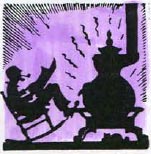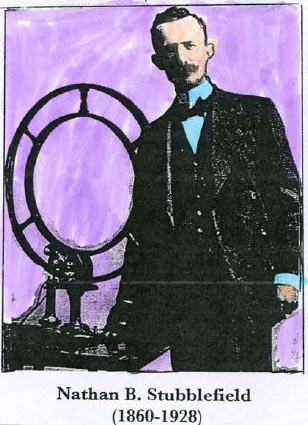 DID A BACKWOODS KENTUCKIAN INVENT RADIO? DID A BACKWOODS KENTUCKIAN INVENT RADIO?
by Dan Hughes © 2010
(From Radio Recall, August 2010)
Here’s a quick quiz:
1. Who invented the light bulb?
2. Who invented the telephone?
3. Who invented radio?
The first two were easy, weren’t they? I know, I know, both are debatable, but the names Thomas Edison and Alexander Graham Bell immediately spring to mind. When it comes to radio, though, a confusing multitude of names scamper through the brain, and none of them are completely satisfying.
THE USUAL SUSPECTS:
Scottish physicist/mathematician James Maxwell, who, in 1864, expanding upon the work of earlier scientists, developed the electromagnetism theory and theorized the existence of radio waves, but was unable to physically demonstrate their existence.
Transplanted British physicist David Hughes (no relation...that I know of), who in 1879 actually transmitted signals that may or may not have been electromagnetic “radio” waves.
German physicist Heinrich Hertz, who in 1886 transmitted radio waves across a room.
Serbian inventor Nikola Tesla, who developed a device capable of radiating radio frequency in 1891, and asserted that this device might well be used for communication.
Russian scientist Alexander Popov, who in 1894 invented a radio receiver that picked up lightning strikes from almost 20 miles away.
Italian inventor Guglielmo Marconi, who was sending wireless Morse code short distances in 1895 and may or may not have sent Morse code across the Atlantic Ocean in 1901.
I’ve left a few other radio pioneers out, like Lee DeForest (inventor of the triode tube, the first practical inexpensive amplifier) and Reginald Fessenden (“father of radio broadcasting”) and Mahlon Loomis (patented the “wireless telegraph”) and several others.
So, who did invent radio? The question can never be answered definitively, but some think it was a simple Kentucky melon farmer.
Nathan B. Stubblefield was born in Murray, Kentucky, in 1860, the son of a prominent lawyer. Stubblefield was orphaned as a young teen, and his formal education ended when he was 14. But he pursued knowledge eagerly, reading everything he could find, and as an adult he ran a school from his home called the Nathan Stubblefield Industrial School. His home was an 85-acre melon farm which is now the home of Murray State University.
Stubblefield dabbled in invention on his farm. He was especially interested in radio communication, and he studied magazines like Scientific American to learn as much as he could about wireless communications. He began building his own equipment, and by 1892 he was giving local demonstrations of his wireless voice telephony. In 1898, he received a patent for an electric battery that he used in his wireless voice transmission experiments in 1898.
On New Year’s Day, 1902, Stubblefield set up a demonstration on the town square of Murray, Kentucky. A crowd of over a thousand spectators saw Stubblefield transmit his voice and music to five receivers placed as far as half a mile away from the transmitter. Two months later, he did a similar demonstration in Washington, D.C. Two months after that he held another demonstration in Philadelphia. The following month he did his demonstration in New York City, but that one fizzled, probably because of the electrical interference caused by the city’s wide-ranging electrical supply system.

In 1909, Stubblefield authorized the creation of a company to sell stock in his transmitting system. He made a poor choice when he picked his administrators, and Stubblefield resigned when he felt the company was using fraudulent sales practices. Several of the founders were later convicted of fraud.
When Stubblefield walked out on his company, he relinquished all rights to his invention.
Undaunted, he began working on a different system of transmitting voice that he had briefly experimented with years earlier. In 1908 he received another patent – this one for a Wireless Telephone System, to be used for "securing telephonic communications between moving vehicles and way stations".
Radio history buffs may remember that Reginald Fessenden claimed to have made a voice and music broadcast on Christmas Eve, 1906. But recent evidence indicates that Fessenden’s broadcast was actually done in 1909, the year after Stubblefield received his patent.
Stubblefield became reclusive after his problems with his stock company, and his life began to fall apart. He was secretive about his work, fearing it would be taken from him like his first transmitting system had been (as far as he was concerned) stolen. His wife left him, and his home (including his workshop) burnt to the ground. He became a drifter, staying with various friends for short amounts of time. On March 28, 1928, Stubblefield was found dead, a victim of self-imposed starvation.
Stubblefield’s legacy may be that he was the true father of broadcasting. “Broadcasting,” after all, means one transmitter and many receivers. But most of the early radio pioneers were seeking improvement in point-to-point transmissions. This is only natural, because wired communications were, by necessity, point-to-point. And “wireless” was conceived as the telegraph or the telephone – both point-to-point systems – without the wires.
But Stubblefield, as early as 1902, was advocating the use of wireless communication as a way for one signal to reach an infinite number of listeners, not just one.
In 1902, Stubblefield was quoted in a St. Louis newpaper as saying of his apparatus, “"..it is capable of sending simultaneous messages from a central distributing station over a very wide territory. For instance, anyone having a receiving instrument … could … be informed of weather news...(and). eventually, it will be used for the general transmission of news of every description".
There are those who argue that Stubblefield’s work fell within the parameters of telephony, not radio. But what is radio? Is it the transmission of electromagnetic waves in a particular broadcast band, or is it a signal that can be received by many listeners at once, without physical connection to the transmitter?
If the latter is correct, then the powers-that-be should give Nathan another look. Perhaps Stubblefield ultimately failed because he was never able to transmit his signals more than a few miles. Still, Murray State Journalism Professor Loren J. Hortin said, "Radio is a device that transmits and receives voice over considerable distance without connecting wires. Stubblefield invented, manufactured, and demonstrated such a device and did so before anyone else on the planet."
ABOUT THE AUTHOR: Dan (danhughes.net) is a retired college broadcasting instructor/radio station manager who does biweekly podcasts and a weekly OTR podcast (radiofun.info), and he writes two monthly columns for a newspaper (theactiveseniors.com). He sells books and manuals he has written at danhughesbooks.com, and he sells autographs (including those of many OTR stars) at danhughesautographs.com. He says none of this impresses his family much.
|